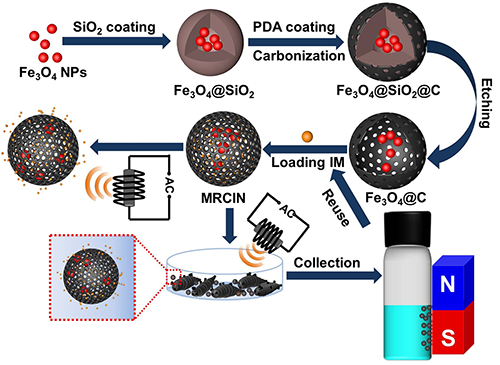| Jul 29, 2021 |
Alternating magnetic field-responsive nano-platform developed for controlled pesticide release
(Nanowerk News) Pesticides play a key role in controlling weeds, pests, and diseases in modern agriculture to promote crop yield. As one of the most extensively used neonicotinoid insecticides, imidacloprid can effectively kill insects.
|
|
However, such pesticides tended to enter the atmosphere, water, and soil easily through runoff, volatilization, and leaching, resulting in serious environmental problems and even hazards to the health of human beings. It’s urgent to develop new methods to control the pesticide loss.
|
|
A joint research team led by Prof. WU Zhengyan from the Hefei Institutes of Physical Science (HFIPS) of the Chinese Academy of Sciences (CAS) developed a novel pesticide system, named magnetic field-responsively controlled-release imidacloprid nano-platform (MRCIN), to improve utilization efficiency of imidacloprid.
|
|
The result was published in ACS Sustainable Chemistry & Engineering ("Alternating Magnetic Field-Responsive Nanoplatforms for Controlled Imidacloprid Release and Sustainable Pest Control").
|
 |
| Schematic illustration of the mechanism. (Image: ZHANG Lihong) (click on image to enlarge)
|
|
In this work, researchers fabricated MRCIN by loading imidacloprid in yolk-shell Fe3O4@C. The Fe3O4@C with a large (Brunauer, Emmett and Teller) BET surface area acted as a carrier for imidacloprid.
|
|
The most interesting thing was that the Fe3O4 (ferrosoferric oxide) nanoparticles in MRCIN could vibrate under varied electromagnetic field to boost release of imidacloprid.
|
|
Therefore, MRCIN presented an excellent alternating magnetic field-responsively controlled-release performance via designing the frequency and voltage. After release, the existence of Fe3O4 nanoparticles was in favor of the collection of MRCIN from water. Besides, MRCIN could be reutilized at least three times.
|
|
The work provides a simple and potential way to achieve the controlled release of imidacloprid, improve utilization efficiency, and decline pollution to environment.
|

